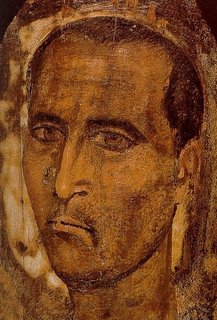Le Amiche
Maybe the best Antonioni movie I've seen yet. It was made a few years before L'Avventura and all the other austere masterpieces, and includes a little more dialogue and dramatic development. The Master was already up to his old tricks (mirror shots, seashore scenes and identity crises galore), and it's tempting to say that here they're not so old.
Clelia (Eleonora Rossi Drago) is in Turin on business to set up a new fashion salon. A chambermaid discovers the lifeless body of a young woman (Madeleine Fischer) in the next room. As the police are interviewing Clelia the next day they are interrupted by the arrival of Momina (Yvonne Furneaux), who has come to visit her friend, who, we learn, has attempted suicide but survived, and is named Rosetta. Clelia is soon drawn into their circle and gets to know Nene and her fiance Lorenzo, and a young woman Mariella (Anna Maria Pancani, who at one point says to her more career oriented friends, "What am I good at? Ask the men, they'll tell you!"). It turns out that Momina is seeing Cesare (Franco Fabrizi), the architect of Clelia's salon. Clelia herself forms a brief attachment to the architect's assistant, Carlo (Ettore Manni). And that's just the beginning of the entanglements in this compelling melodrama.
Clelia (Eleonora Rossi Drago) is in Turin on business to set up a new fashion salon. A chambermaid discovers the lifeless body of a young woman (Madeleine Fischer) in the next room. As the police are interviewing Clelia the next day they are interrupted by the arrival of Momina (Yvonne Furneaux), who has come to visit her friend, who, we learn, has attempted suicide but survived, and is named Rosetta. Clelia is soon drawn into their circle and gets to know Nene and her fiance Lorenzo, and a young woman Mariella (Anna Maria Pancani, who at one point says to her more career oriented friends, "What am I good at? Ask the men, they'll tell you!"). It turns out that Momina is seeing Cesare (Franco Fabrizi), the architect of Clelia's salon. Clelia herself forms a brief attachment to the architect's assistant, Carlo (Ettore Manni). And that's just the beginning of the entanglements in this compelling melodrama.


1 Comments:
Complex, dramatic, and visually seductive, "Le Amiche" is not just a fine early work by Antonioni, it deserves a place beside his more famous achievements.
For those approaching it in 'historical reverse', that is AFTER knowing the 'Trilogy' ("L'Avventura" "La Notte" "L'Eclisse") and "Il Deserto Rosso", the film is stunning in the way it prefigures nearly all the themes the director would continue to explore in his somewhat more daring works of the 1960s. In the character of Clelia (played by the beautiful Eleonora Rossi Drago) can be seen the ancestor of Monica Vitti's Claudia in "L'Avventura": she is an outsider, curious and compassionate, who is coming to terms with her own sense of self. Gabriele Ferzetti plays Lorenzo, a frustrated artist, much like his lost architect in the same famous film. And in Rosetta (Madeleine Fisher) is prefigured the enigmatic Anna go 'goes missing' on the immortal volcanic island. Yvonne Furneaux's Momina embodies the superficial leisure class characters with whom Antonioni will continue to populate his next three or four films. And Nene (Valentina Cortese) acts out the director's great theme of forgiveness.
But it is not just in the characters that "Le Amiche" points toward the future. There are many scenes of wandering, along city streets, or beaches. Casual sexuality it presented not for its sensual or aesthetic appeal, but as an empty attempt to connect. And the great chasm of miscommunication between men and women is on full view. Yet, even in 1955 the director knows that all is not black and white. Characters of the same gender don't really understand one another either. The film seems to ask a difficult question: is it possible to 'be yourself' and still need others? Clelia finds a difficult answer, while Nene seems to find its mirror image.
And speaking of mirrors, the famous 'doubling' technique is here in germ form as well. In the very opening shot, Clelia looks into the hotel bathroom mirror while drawing her bath: she is about to find her self divided in her feelings about her soon-to-be new friends and her old home town of Torino. Later, she regards her reflection in a shop window mirror before deciding to pursue a romance with the handsome Carlo (Ettore Manni).
Possibly most interesting of all is Rosetta, who, in attempting suicide, is trying to 'disappear'. The film makes it more than clear that this character has no real sense of self: she is dependent upon the affections of a man and the perceived loyalty of her mostly vacant friendships. There is a telling scene with Lorenzo in which she feeds off his flattery. And, in a beautifully acted scene aboard a train, Clelia tries to help her understand the importance of connection to others, never realizing how unstable Rosetta truly is.
Antonioni would in his next feature, the marvelous "Il Grido", begin to streamline his technique. "Le Amiche" has far more characters than he would later prefer, and they talk constantly. There are virtually none of the characteristic, nearly silent sequences that will inform his later works. Nor does landscape play the commanding role it will assume in the 1960s. Also, the two main narrative threads of "Le Amiche" (Clelia and Rosetta/Lorenzo/Nene) will be reduced to one for nearly all his remaining films.
Essential Antonioni.
Post a Comment
<< Home